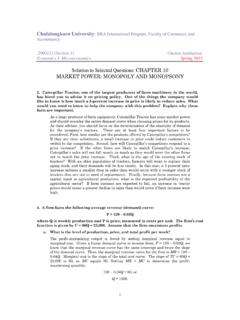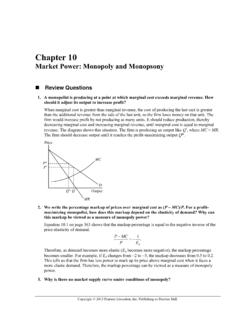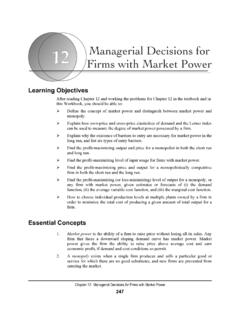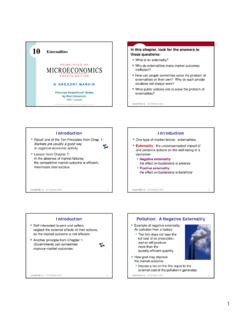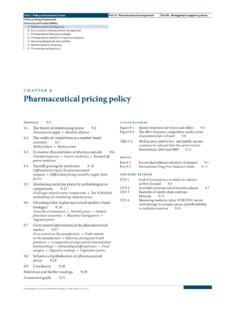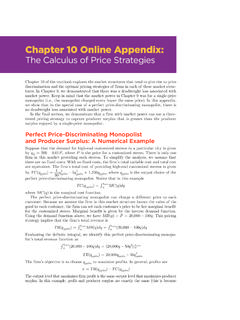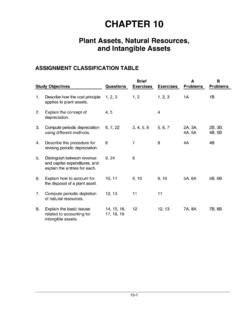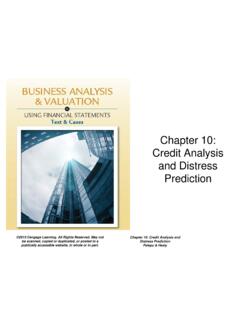Transcription of CHAPTER 11 CHAPTER OUTLINE - unipd.it
1 CHAPTER 11. Monopoly CHAPTER OUTLINE . Monopoly Profit Maximization Marginal Revenue A Monopoly Chooses Price or Quantity Graphical Approach Mathematical Approach market power market power and the Shape of the Demand Curve Lerner Index Causes of market power Effects of a Shift of the Demand Curve Welfare Effects of Monopoly Graphing the Welfare Loss Welfare Effects of Ad Valorem Versus Specific Taxes Cost Advantages that Create Monopolies Sources of Cost Advantages Natural Monopoly Government Actions That Create Monopolies Barriers to Entry Patents Government Actions That Reduce market power Regulating Monopolies Increasing Competition
2 Dominant Firm and Competitive Fringe TEACHING TIPS. CHAPTER 11 begins the study of monopoly and concentrated markets. Most of the CHAPTER focuses on monopoly, followed by a brief discussion of dominant firm with competitive fringe. You might want to maintain a running connection to the material in Chapters 8 and 9 by comparing the competitive solution or assumption to that of monopoly throughout the early portion of the CHAPTER . This will be helpful in the later stages when evaluating deadweight loss and the comparison of efficient levels to monopoly output and price levels. Before beginning the material on profit maximization it is worth the time to discuss the concept of market edges.
3 Because monopolies only exist when a product has no close substitutes, the class should see that a monopoly on Ford pick-up trucks is not meaningful. This will provide context for the discussion of elas- ticity and market power that begins with the relationship among price, marginal revenue and elasticity in equation , and continues in Section The United States Postal Service (which is mentioned in the text) is a great example to discuss, as most students are very familiar with the changes that have occurred in communication technology. Students used to free access to e-mail through the campus network are like- ly to have highly elastic demand for first class mail.
4 In the presentation on profit maximization, two points tend to slow students down. The first is the rela- tionship between marginal revenue and price. If you are restricting your demand curves to be linear and are using even basic calculus, the price marginal revenue relationship is greatly simplified. Although memorization is generally to be discouraged, if students remember the same intercept, twice the slope . relationship between linear demand curves and their associated marginal revenue curves, it might pre- vent a silly mistake on an exam. The shut-down point is the other point that occasionally throws stu- dents, as it implies that a monopolist might not earn profits.
5 When students think of monopolies, they 69. 70 Part One\Teaching Aids usually associate them with high prices and profits, not the need to shut down. It is also worth using a graph to show a comparison to the shutdown rule for the competitive firm. Section , which covers the measurement of welfare loss, is extremely important. In order for students to be able to assess monopoly effects at more than the most superficial level (price is higher, output is lower), they must understand the concept of deadweight loss. You might use a current event, such as the introduction of competition to the residential electricity industry, to discuss the relationship among the inelasticity of demand, the magnitude of the welfare loss, and the importance of substitutes.
6 As demand elasticity decreases, loss of consumer surplus increases. Because consumers have historically had no alter- natives for commodities such as electricity and local telephone service, demand was highly inelastic. Further, scale economies have made break-ups unwise, with the result that utilities have been heavily reg- ulated to reduce welfare loss. Recent changes in technology have created the opportunity to replace regu- lation with competition, which would increase the elasticity of demand faced by individual firms, thus cre- ating incentives for lower prices and increased efficiency. The discussion of entry barriers in the text, with the exception of patents, is limited mostly to exogenous barriers such as cost advantages due to scale economies and government actions such as the postal service or licensing laws.
7 Strategic actions such as advertising, product tie-ins, and raising rival's costs are dis- cussed in CHAPTER 14. If you will not have time to cover all of CHAPTER 14 later in the course, you might want to spend a few minutes discussing how firms can try to create barriers to entry, and give some exam- ples. You may be able to generate a good class discussion on the subject of patents. I present them as the classic example of a double-edged sword creating the incentive to innovate on the one hand, but at the same time creating a legal monopoly. Students often will give the quick response of too expensive if asked about pharmaceuticals.
8 This is likely because they have not considered the alternatives, which are less research and development, and fewer new medicines. The line between too much protection for firm innovations and not enough protection, is difficult to determine. Recent changes in patent law such as the Drug Price Competition and Patent Term Restoration Act in 1984 have moved this line toward more pro- tection in the short run, and increased competition in the long run. This new law reduces the time required to approve generic equivalent drugs, decreasing the time lag between the expiration of a patent and the introduction of substitutes.
9 It also allows for the extension of patents by up to five years to replace time lost in the FDA approval process, increasing the incentive for firms to innovate. ADDITIONAL APPLICATION. The Creation and Destruction of an Aluminum Monopoly1. Cost advantages and government actions allowed the Aluminum Company of America (Alcoa) to maintain a monopoly in aluminum in the United States. Eventually, however, government and judicial action destroyed Alcoa's monopoly. In 1893, Alfred Hall invented and patented a new process that allowed his firm, Pittsburgh Reduction (which became Alcoa) to produce aluminum at much lower cost than his competitors.
10 Over time, this firm obtained control of most domestic and many international sources of bauxite ore, which is necessary to produce aluminum. As a result, Alcoa was the only American producer of aluminum. Alcoa did face some competition from foreign producers; however, the United States established high tariffs on aluminum imports, which reduced this threat to Alcoa's market power . During World War I, when foreign competitors were unable to effectively produce and sell in other coun- tries, Alcoa became an exporter. It continued to export after the war. Between the two world wars, Alcoa remained the only aluminum smelter (producer) in the United States due to its technological advantages and economies of scale.



